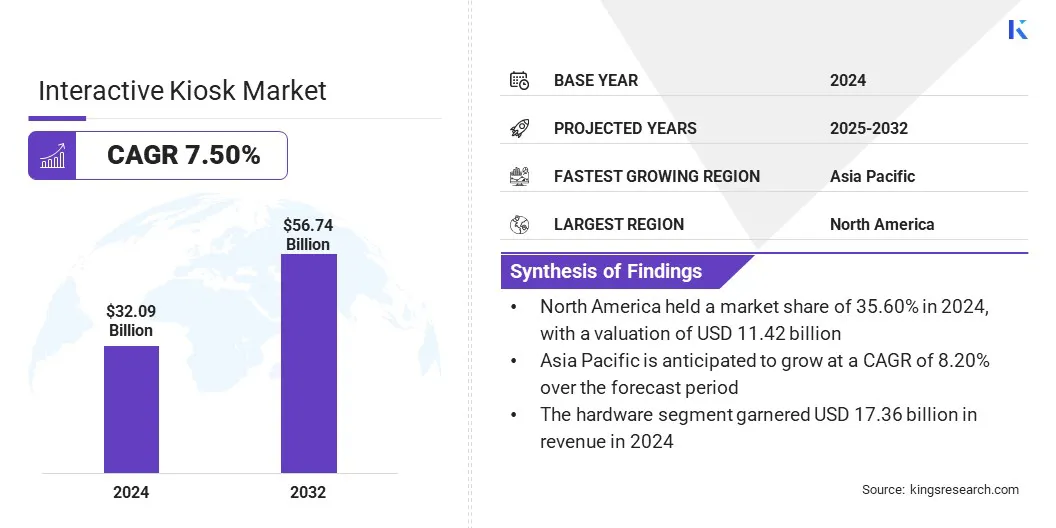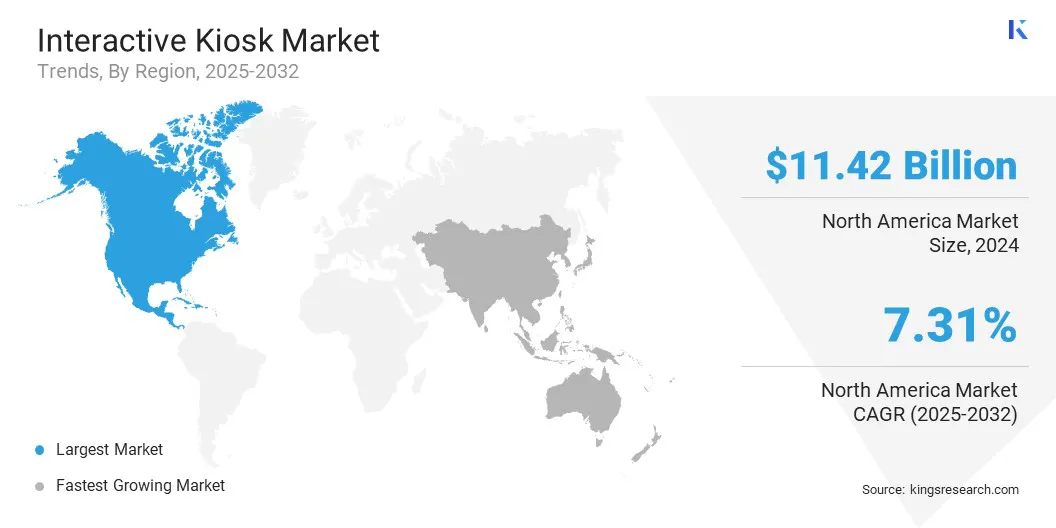Market Definition
The market comprises a broad range of self-service systems integrated across sectors such as retail, healthcare, banking, hospitality, and transportation. It includes supporting infrastructure, software platforms, and service networks that enable user-driven transactions, information access, and customer engagement.
The report offers a thorough assessment of the main factors driving market expansion, along with detailed regional analysis and the competitive landscape influencing industry dynamics.
Interactive Kiosk Market Overview
The global interactive kiosk market size was valued at USD 32.09 billion in 2024 and is projected to grow from USD 34.20 billion in 2025 to USD 56.74 billion by 2032, exhibiting a CAGR of 7.50% during the forecast period.
The market is evolving rapidly as organizations across industries adopt digital self-service technologies to enhance user convenience and streamline operations. Increasing use in areas such as ticketing, wayfinding, check-in, and payment is further fueling this growth, particularly in retail, transportation, and healthcare environments.
Major companies operating in the interactive kiosk industry are Meridian Kiosks, NCR Voyix Corporation, Diebold Nixdorf, Incorporated, REDYREF, GLORY LTD., Olea Kiosks Inc., Frank Mayer and Associates, Inc., Advanced Kiosks, Embross, Peerless-AV, Advantech Co., Ltd., Pyramid Computer GmbH, Zebra Technologies Corp., Phoenix Microsystems, and Mantra Softech (India) Pvt. Ltd.
Integration with mobile wallets, cloud-based services, and real-time content management is expanding functionality and improving efficiency. The growing trend of digitalization in sectors such as retail, healthcare, and hospitality is contributing to market expansion, as businesses increasingly adopt interactive kiosks to meet evolving consumer needs.
- In May 2024, NCR Voyix and GRUBBRR partnered to introduce the Aloha Kiosk, powered by GRUBBRR. The kiosk solution integrates with the NCR Voyix Commerce Platform to enhance customer experience, improve operational efficiency, and address labor challenges in the restaurant industry.

Key Highlights
- The interactive kiosk market size was valued at USD 32.09 billion in 2024.
- The market is projected to grow at a CAGR of 7.50% from 2025 to 2032.
- North America held a market share of 35.60% in 2024, with a valuation of USD 11.42 billion.
- The hardware segment garnered USD 17.36 billion in revenue in 2024.
- The self-service kiosks segment is expected to reach USD 17.51 billion by 2032.
- The retail segment is projected to generate a revenue of USD 19.00 billion by 2032.
- Asia Pacific is anticipated to grow at a CAGR of 8.20% over the forecast period.
Market Driver
Rising Demand for Operational Efficiency and Enhanced Customer Experience
The market is experiencing significant growth due to the increasing adoption of digital transformation across various industries, including foodservice, retail, and healthcare.
As businesses strive to enhance customer experiences and improve operational efficiency, interactive kiosks provide a versatile solution. These kiosks enable businesses to streamline services, offering self-service options that reduce wait times and enhance user convenience.
Additionally, by integrating digital systems, interactive kiosks improve accessibility for customers, enabling them to interact with services seamlessly. The continued rise in digital adoption is expected to propel market expansion, as organizations seek to meet growing consumer demands for quicker, more efficient, and user-friendly services.
- In April 2024, Fiserv launched Clover Kiosk, integrated with the newly enhanced Clover Kitchen Display System, to enable end-to-end order management for quick- and full-service restaurants. The solutions aim to streamline restaurant operations and enhance customer experience, offering up to 40% lower total cost of ownership than competitors.
Market Challenge
System Downtime and Maintenance
A major challenge imeding the expansion of the interactive kiosk market is the risk of system downtime and ongoing maintenance demands. Interactive kiosks operate in various public settings and must function reliably to deliver seamless user experiences. However, issues such as software malfunctions, hardware failures, or connectivity disruptions can lead to kiosk outages.
These interruptions disrupt user experience, resulting in missed business opportunities and diminished operational efficiency for organizations. Regular servicing, particularly across large-scale deployments, can be resource-intensive and costly.
To address this, companies are increasingly implementing remote monitoring tools and predictive maintenance solutions that enable real-time diagnostics and proactive support,minimizing downtime and extending kiosk system lifespan.
Market Trend
Advancing User Interaction with AI and Voice-Enabled Technologies
The market is evolving with the integration of advanced technologies that enhance both functionality and user experience. A key trend is the adoption of AI-driven features enabling intelligent personalization, faster service, and more dynamic customer engagement.
Voice-enabled interfaces, powered by conversational AI, are increasingly complementing traditional touchscreens. This development improves accessibility and allows for more seamless, hands-free interactions, particularly in environments prioritizing hygiene and convenience. Combined with capabilities such as real-time data processing and behavior analytics, these innovations are setting new standards for customer-centric kiosk solutions.
- In May 2025, Cerence Inc. expanded its collaboration with Code Factory to launch VoiceTopping, a conversational AI solution that enables voice interaction in self-service kiosks across retail, hospitality, healthcare, banking, and other sectors.
Interactive Kiosk Market Report Snapshot
|
Segmentation
|
Details
|
|
By Component
|
Hardware, Software, Services
|
|
By Kiosk Type
|
Self-service Kiosks, Information Kiosks, Ticketing & Check-in Kiosks, Payment Kiosks, Wayfinding Kiosks, Others
|
|
By End-use Industry
|
Retail, BFSI, Healthcare, Hospitality & Entertainment, Transportation, Government/Public Sector
|
|
By Region
|
North America: U.S., Canada, Mexico
|
|
Europe: France, UK, Spain, Germany, Italy, Russia, Rest of Europe
|
|
Asia-Pacific: China, Japan, India, Australia, ASEAN, South Korea, Rest of Asia-Pacific
|
|
Middle East & Africa: Turkey, U.A.E., Saudi Arabia, South Africa, Rest of Middle East & Africa
|
|
South America: Brazil, Argentina, Rest of South America
|
Market Segmentation
- By Component (Hardware, Software, and Services): The hardware segment earned USD 17.36 billion in 2024 due to the widespread deployment of durable and advanced interactive terminals across high-traffic environments.
- By Kiosk Type (Self-service Kiosks, Information Kiosks, Ticketing & Check-in Kiosks, Payment Kiosks, Wayfinding Kiosks, and Others): The self-service kiosks segment held a share of 36.40% in 2024, fueled by growing consumer preference for fast, contactless transactions and reduced wait times.
- By End-use Industry (Retail, BFSI, Healthcare, Hospitality & Entertainment, Transportation, and Government/Public Sector): The retail segment is projected to reach USD 19.00 billion by 2032, propelled by the increasing integration of kiosks for product browsing, self-checkout, and in-store digital engagement.
Interactive Kiosk Market Regional Analysis
Based on region, the market has been classified into North America, Europe, Asia Pacific, Middle East & Africa, and South America.

The North America interactive kiosk market accounted for a substantial share of 35.60% in 2024, valued at USD 11.42 billion. This dominance is primarily attributed to the widespread deployment of interactive kiosks across retail chains, airports, hospitals, and banking facilities in the U.S. and Canada.
High consumer acceptance of self-service technologies, along with heavy investment by large retailers and financial institutions in digital infrastructure, has significantly boosted regional market expansion. Additionally, the strong presence of key industry players and early adoption of innovations such as AI-powered kiosks and biometric-enabled interfaces have solidified North America's leading position.
Asia Pacific interactive kiosk industry is expected to register the fastest CAGR of 8.20% over the forecast period. Rapid urbanization, a rising middle-class population, and the ongoing expansion of modern retail formats in countries such as China, India, Japan, and South Korea are further supporting this growth.
High foot traffic in transportation hubs, growing demand for multilingual user interfaces, and increased kiosk adoption in sectors such as healthcare and education are fueling regional market growth. Moreover, local manufacturers offering cost-effective kiosk solutions are supporting broader penetration across both metropolitan and tier-two cities.
Regulatory Frameworks
- In the U.S., kiosk accessibility is governed by the Americans with Disabilities Act (ADA), which requires features such as voice output, tactile input, appropriate screen height, and alternative navigation methods to ensure usability for individuals with disabilities.
- In Europe, the European Accessibility Act mandates that kiosks used in public and private services meet accessibility requirements, including design and functionality standards that ensure equal access for people with disabilities.
Competitive Landscape
The interactive kiosk market is characterized by leading players emphasizing innovation and strategic collaborations to maintain market share.
Key strategies include the development of industry-specific kiosk solutions with enhanced user interfaces, integration of cloud-based management platforms, and remote diagnostics capabilities. Companies are actively adopting mergers and acquisitions to expand geographically and access new customer bases.
Partnerships with software vendors and digital service providers are also common to improve system interoperability and service customization. Additionally, companies are focusing on expanding their product portfolios to include advanced features such as touchless interaction, biometric authentication, and AI-driven analytics to meet evolving customer demands.
- In April 2024, Worldline and Tabesto launched the first all-in-one ordering and payment kiosk, integrating SoftPOS 'Worldline Tap on Mobile' technology. The kiosk enables contactless payments and reduces customer wait times while simplifying operational management for merchants.
List of Key Companies in Interactive Kiosk Market:
- Meridian Kiosks
- NCR Voyix Corporation
- Diebold Nixdorf, Incorporated
- REDYREF
- GLORY LTD.
- Olea Kiosks Inc.
- Frank Mayer and Associates, Inc.
- Advanced Kiosks
- Embross
- Peerless-AV
- Advantech Co., Ltd.
- Pyramid Computer GmbH
- Zebra Technologies Corp.
- Phoenix Microsystems
- Mantra Softech (India) Pvt. Ltd.
Recent Developments (Acquisition/Product Launches)
- In April 2025, Lids, a global sports retailer, launched the Custom Zone with interactive "Build-A-Cap" kiosks. The new store format offers expanded customization options for hats and jerseys, along with localized and exclusive merchandise.
- In December 2024, Deliverect acquired Tabesto, a provider of all-in-one ordering kiosks for fast-food restaurants. Tabesto will continue operating as “Tabesto by Deliverect” in France and Switzerland, while its solutions will be branded as the Deliverect Kiosk in other markets.
- In May 2023, Samsung Electronics launched the KMC-W, a Windows 10 IoT Enterprise-powered Kiosk with a 24-inch interactive display. The Kiosk offers expanded software compatibility and high performance for various industries, including food and beverage, retail, and healthcare.


